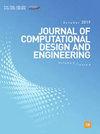Crack growth degradation-based diagnosis and design of high pressure liquefied natural gas pipe via designable data-augmented anomaly detection
IF 6.1
2区 工程技术
Q1 COMPUTER SCIENCE, INTERDISCIPLINARY APPLICATIONS
引用次数: 0
Abstract
A new approach to anomaly detection termed “anomaly detection with designable generative adversarial network (Ano-DGAN)” is proposed, which is a series connection of a designable generative adversarial network and anomaly detection with a generative adversarial network. The proposed Ano-DGAN, based on a deep neural network, overcomes the limitations of abnormal data collection when performing anomaly detection. In addition, it can perform statistical diagnosis by identifying the healthy range of each design variable without a massive amount of initial data. A model was constructed to simulate a high-pressure liquefied natural gas pipeline for data collection and the determination of the critical design variables. The simulation model was validated and compared with the failure mode and effect analysis of a real pipeline, which showed that stress was concentrated in the weld joints of the branch pipe. A crack-growth degradation factor was applied to the weld, and anomaly detection was performed. The performance of the proposed model was highly accurate compared with that of other anomaly detection models, such as support vector machine (SVM), one-dimensional convolutional neural network (1D CNN), and long short term memory (LSTM). The results provided a statistical estimate of the design variable ranges and were validated statistically, indicating that the diagnosis was acceptable.基于可设计数据增强异常检测的高压液化天然气管道裂纹扩展退化诊断与设计
提出了一种新的异常检测方法“可设计生成对抗网络异常检测(Ano-DGAN)”,它是可设计生成对抗网络与生成对抗网络异常检测的一系列联系。本文提出的基于深度神经网络的Ano-DGAN,克服了异常检测时异常数据采集的局限性。此外,它可以在没有大量初始数据的情况下,通过识别每个设计变量的健康范围来进行统计诊断。建立了高压液化天然气管道仿真模型,进行了数据采集和关键设计变量的确定。对仿真模型进行了验证,并与实际管道的失效模式和影响分析进行了对比,结果表明,应力集中在支管焊缝处。将裂纹扩展退化因子应用于焊缝,并进行异常检测。与支持向量机(SVM)、一维卷积神经网络(1D CNN)、长短期记忆(LSTM)等异常检测模型相比,该模型具有较高的准确率。结果提供了设计变量范围的统计估计,并经过统计验证,表明诊断是可接受的。
本文章由计算机程序翻译,如有差异,请以英文原文为准。
求助全文
约1分钟内获得全文
求助全文
来源期刊

Journal of Computational Design and Engineering
Computer Science-Human-Computer Interaction
CiteScore
7.70
自引率
20.40%
发文量
125
期刊介绍:
Journal of Computational Design and Engineering is an international journal that aims to provide academia and industry with a venue for rapid publication of research papers reporting innovative computational methods and applications to achieve a major breakthrough, practical improvements, and bold new research directions within a wide range of design and engineering:
• Theory and its progress in computational advancement for design and engineering
• Development of computational framework to support large scale design and engineering
• Interaction issues among human, designed artifacts, and systems
• Knowledge-intensive technologies for intelligent and sustainable systems
• Emerging technology and convergence of technology fields presented with convincing design examples
• Educational issues for academia, practitioners, and future generation
• Proposal on new research directions as well as survey and retrospectives on mature field.
 求助内容:
求助内容: 应助结果提醒方式:
应助结果提醒方式:


